Be an Eagle County NeighBEARhood Ambassador!
If you live in Eagle County, you’ve made your home in black-bear habitat. Black bears (Ursus...

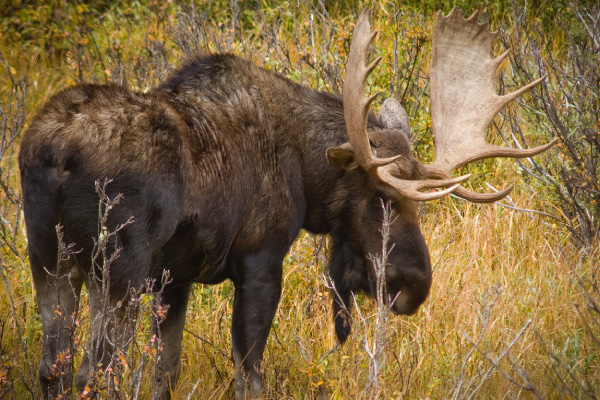
The Rut is the mating season for many ruminant mammals. In Colorado that would include ruminants like elk, deer, moose, bighorn sheep, pronghorn, and bison. Each species has a rutting season that is different than the others. In addition, the behavior for each of the species is different, but it all has one goal: producing future generations.
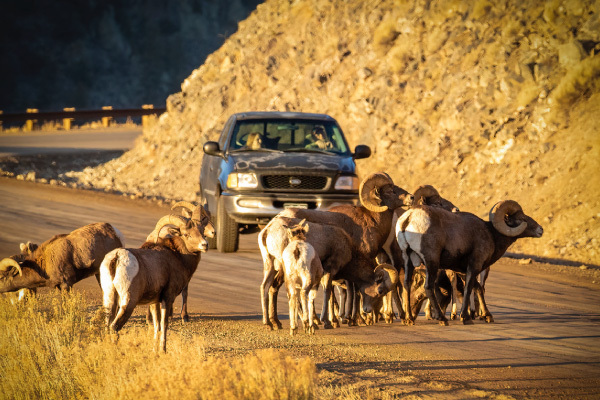 During the rut, animals often travel great distances and cross roadways, particularly at dawn and dusk.
During the rut, animals often travel great distances and cross roadways, particularly at dawn and dusk.
What causes the rut to begin? The tilt of the Earth on its axis causes the day length to change through the year. That is called the photoperiod (amount of daylight each day). As darkness increases a hormone called melatonin, which is produced by the pineal gland in the brain, begins to increase and that is what triggers females to come into estrus. In males, melatonin increases the levels of testosterone. The behavioral and physiological shifts observed during the rut are triggered by these hormones and that leads to the behavior we observe during the breeding season.
Elk - mid-September to mid-October. Deer - the last seven to 10 days in October, and can last into early November.
Moose - mid- to late September and runs through October. Bighorn sheep - late November through January.
Mt Goat - Late October through December. Pronghorn - September through October. Bison - June to September
Why does the rut occur in the fall? The rut is timed so that the young are born in the spring, which is the peak of the nutritional value in foods for the female and her offspring. It is also warmer and reduces the possibility of hypothermia in the young. All of this increases the potential survivability of the young.
The timing of the rut is much more precise in northern regions than in southern areas. This may be due to a more rapid change in darkness and the fact that the northern climate timing is more important for female and young survival. Animals that live in higher altitudes also have a later rut and a later birthing season.
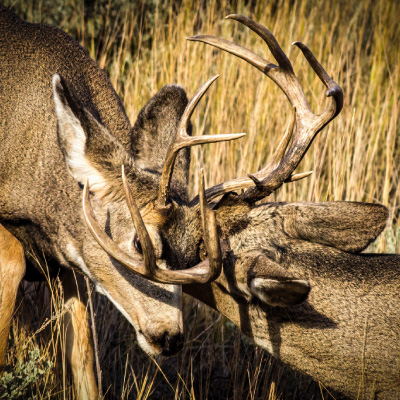 Battles among male mule deer during the rut are common.
Battles among male mule deer during the rut are common.
For the males with antlers (deer, elk, and moose), the hormone changes cause antler development, the development of the testes, and muscle building. At the beginning of the rut, the antlers mineralize, and bucks and bulls shed their velvet, which is a skin covering containing blood vessels and nerves to help with antler growth. Antlers are made of bone. Elk antlers can weigh up to 40 pounds and may grow at a rate of one inch per day.
At the time of the rut, males begin rubbing trees, to scrape off the velvet. The males become more aggressive and begin sparring. Though animals with horns (mt goats, and bighorn) do not shed them as is done with antlers, the males still go through a similar period of behavioral and physiological shifts.
We generally think of the rut as a period in the fall and early winter when the males have increased aggression and a greater interest in females. During the rut the males of the species wallow and mark themselves with mud, produce secretions from glands, and soak themselves in their own urine. They also may become vocal, as in the incredible bugling of elk and the bellowing of bison. Males may also demonstrate by thrashing trees and bushes. All of that may make themselves more visually appealing to the females. Fights between the males with antlers are more of a pushing match though they can get incredibly violent.
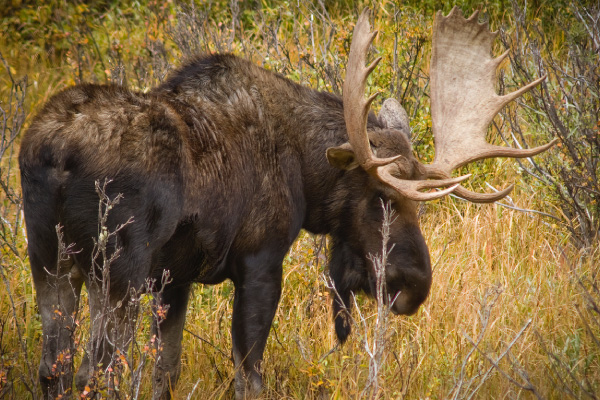 Antlers on a bull moose may- reach 40 pounds.
Antlers on a bull moose may- reach 40 pounds.
Males also use olfaction to entice females to mate using secretions from glands. Many species release pheromones from the preorbital gland, a slit immediately forward of a male’s eye. The gland produces secretions containing pheromones. Male elk, deer, and moose will rub the side of their face on bark and branches to “paint” them with unique secretions to communicate their sexual status.
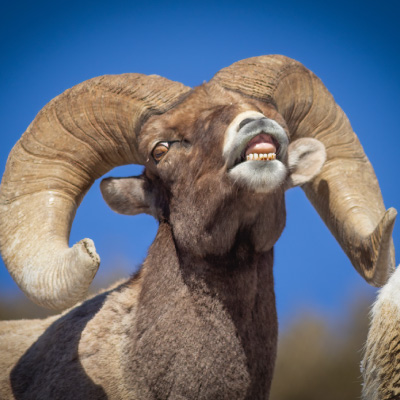 The pheromones emitted by females are detected by the males and are the trigger
The pheromones emitted by females are detected by the males and are the trigger
for the males knowing when the females are receptive to their advances.
The rut for bighorn is the last two weeks of November and the first two weeks of December. Horns in sheep and goats are retained for their lifetimes. Horns are made of the same material as fingernails. The rut in bighorn is characterized by rams crashing headlong into each other in a fight for dominance where the higher-ranking rams do most of the breeding. The rams collide in fights at 20-25 miles per hour dozens of times per day and do not sustain concussions. Do they even get headaches? Humans do not survive forces of that type. The shape of the bighorn skull does little to cushion the brain. It is believed that the sheep are protected by a mechanism in the brain that increases blood volume that fills their brains’ vessels, creating what some call the Bubble Wrap effect. Something that helmets cannot do in humans.
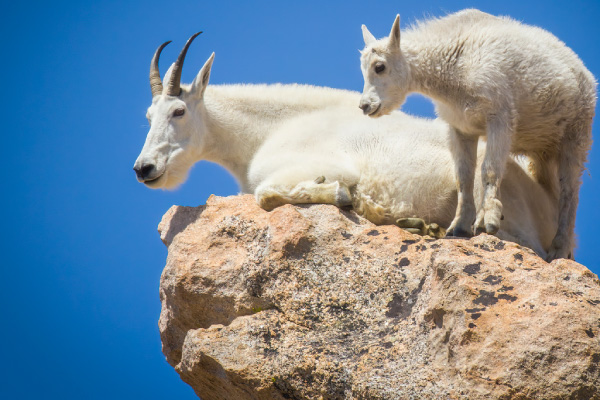 Mountain Goats live at high elevations and have a later rut that allows the young to be born later in the spring.
Mountain Goats live at high elevations and have a later rut that allows the young to be born later in the spring.
The rut for mountain goats does not really involve the same level of fighting. They tend to posture and fake a charge, with little contact. By the way, mountain goats are not goats. They are more closely related to antelope than goats.
 The pronghorn rut may be curtailed when there is significant snow.
The pronghorn rut may be curtailed when there is significant snow.
That brings us to the pronghorn, also called American antelope, but they are not related to antelope, they are more closely related to the giraffe. Getting confused yet? Pronghorns have horns that are shed each year like antlers in deer and elk. They tend to get into pushing and shoving fights like deer and elk.
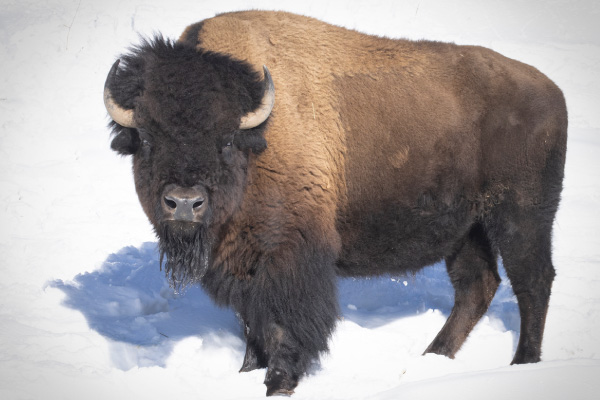
The bison, also called buffalo (it is only distantly related to the true buffalo, African buffalo, and the water buffalo) is the largest surviving terrestrial animal in North America. Bison were hunted close to extinction during the 19th and 20th centuries but have since rebounded. There are no wild bison in Colorado, though there are areas where Bison are found in large ranches and refuges in Colorado. These animals are often unpredictable. They may seem unconcerned, or even lazy, but may attack anything, without any warning or apparent reason. They can gallop at 35 mph for long distances.
The bison rut lasts each year from June to September, with most of the activity occurring between July and August. They bellow during the rut and fights can get to be violent.
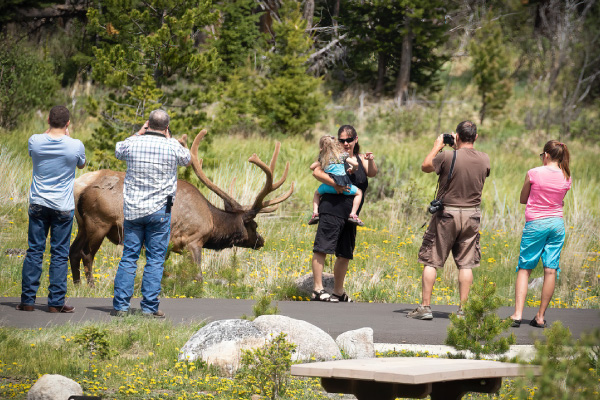 This is a REALLY bad idea! Many people are injured or killed each year by getting too close to wildlife.
This is a REALLY bad idea! Many people are injured or killed each year by getting too close to wildlife.
The annual rut is something to watch, but you need to be careful around these animals. Photography during the rut can be fun. Keep in mind that smartphones have wide angle lenses and to fill the frame it is tempting to try and get closer. Do not attempt to get close for a photo or a selfie! The males often act aggressively in the fall and winter. They have only one thing on their mind, and they may become agitated when other animals, objects, or people appear to be posing a challenge. People that shoot selfies of wildlife turn their back on the animals to do that and may have little time to react should the animal charge.
Animals are often on the move during the rut. They follow corridors to areas where the males and females congregate. Their movement is often at dusk and dawn when they may be harder to see when driving. Stay alert on the highways.
Dogs tend to trigger aggressive behavior, particularly around moose. Dogs around these animals can be badly injured by antlers and hooves. Worse yet, dogs run back to their human, and bring the agitated deer, elk, or moose with them. Keep your dogs on a leash and stay a safe distance from these animals. Never let your dog chase deer or other wildlife.
This time of year, it is a good idea to remove items from yards in which antlered animals can be entangled. Antlered animals tend to get tangled up in hammocks, swings, lawn chairs, hanging lights, and a lot of other yard items. They may end up “wearing” those ornaments until the antlers are shed in the spring.
The rut for these animals is also during various hunting seasons. It is important to know when the various hunting seasons are in areas where you hike. Think about hiking inside National and State Parks where there is no hunting season. Stay on trails or roads. Hike during daylight and avoid hiking when visibility is reduced, and wildlife is active. Wear bright visible colors and make human noises.
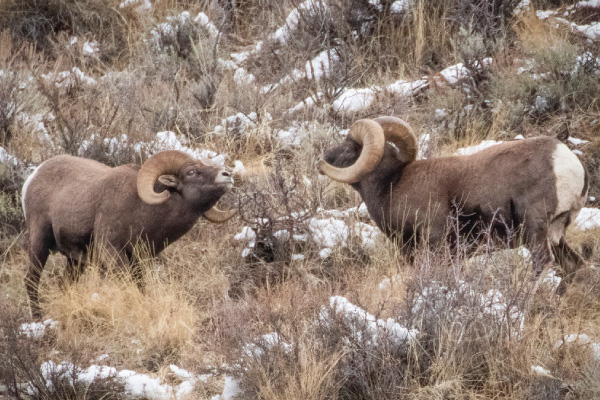 Battles between bighorn rams is an impressive sight. They can go on for hours.
Battles between bighorn rams is an impressive sight. They can go on for hours.
Be smart around wildlife. Their lives and yours may depend on it.

Rick Spitzer is the author of the article and official photographer for Eagle County Community Wildlife Roundtable.
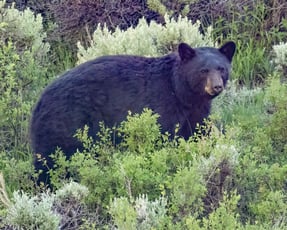

If you live in Eagle County, you’ve made your home in black-bear habitat. Black bears (Ursus...

